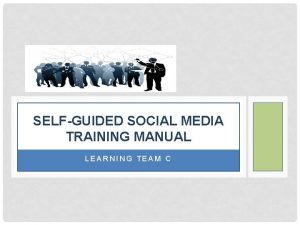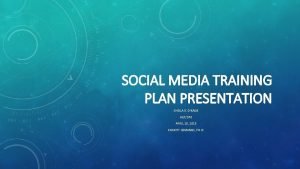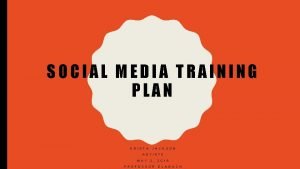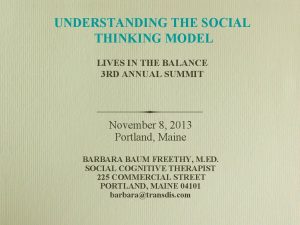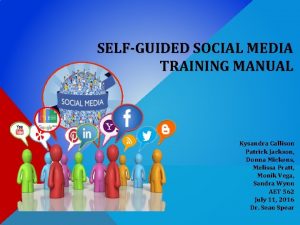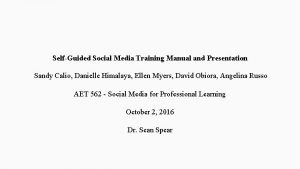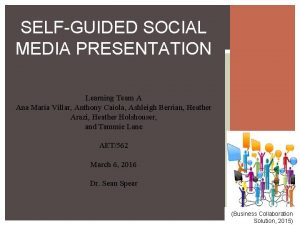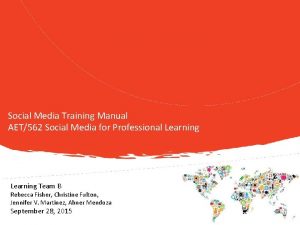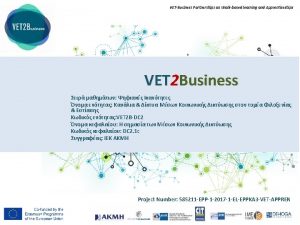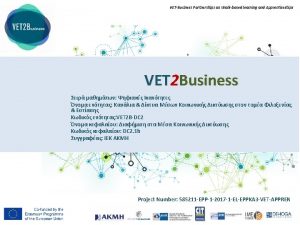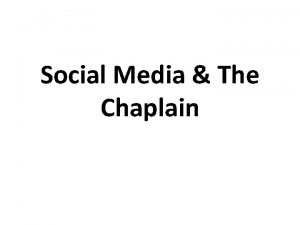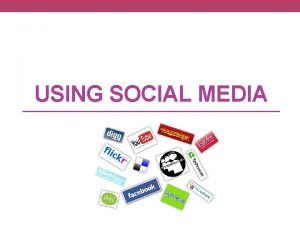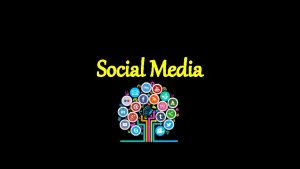SELFGUIDED SOCIAL MEDIA TRAINING MANUAL LEARNING TEAM C












- Slides: 12

SELF-GUIDED SOCIAL MEDIA TRAINING MANUAL LEARNING TEAM C

OVERVIEW ü The Self-Guided Social Media Training Manual is to assist in the benefits of using social media tools to increase social learning. ü The use of social media tools will expand their interaction. ü The guide will demonstrate ways to collaborate and increase interaction among employees. ü It is vital to an organization that all employees are versed on social learning. ü Employees will see how learning breaks the boundaries of traditional training by allowing each employee to participate in discussions. ü It allows employees to seek out information from experts in their own field in a way that is personal to them and removes the constraints of time and distance. ü This learning can be shared in order to deepen the discussion and learning of all who participate. Sel f Ma -Guide nua d. S l oci al M edi a. T rain ing

OVERVIEW The main objectives of the manual is to: 1. 2. 3. 4. Main Objective Help readers gain a broader understanding of how social media can be used for training purposes. Problem solving through social learning Addressing business issues Strengthening relationships through social media When launching new social media tools in any organization, it is imperative to consider: 1. 2. 3. 4. Which tool fits the instructional goal The amount of time required for instruction If the tool encourages collaboration What the guidelines are for the use of the selected tool. • Guidelines are imperative in order to keep members accountable to deadlines and codes of professional conduct.

OVERVIEW • This manual provides detailed explanations of four such social media tools: Four social media: 1. Wikis 2. Twitter 3. Voice Thread 4. Facebook • These social media tools can be very beneficial to collaborative learning in any organization. • The guide will provide an in depth look into their benefits and applications in order to help employees gain more insight into the power of social learning.

BARRIERS TO SOCIAL LEARNING Positives: A. B. C. D. E. F. Allows for a greater opportunity to expand collaboration Provides creative collaborative connections Aids in gathering data through social media outlets that connect customers quickly Corrects problems and enlightens what is being successful Social learning has the ability to bring many people together quickly Communication can be much timelier and problems can be addressed sooner. Negatives: A. B. C. D. What is written or posted can be taken out of context or misconstrued Employees can feel their performance is being questioned if others are brought in to collaborate Division among employees and leadership Formal training can take time to set up and ensure that all required have the opening on their schedule Similarities: • The similarity between social learning and formal training are that people are brought together. • Collaboration usually proves beneficial to all. Normal processes can impede progress because of time delays in getting all invested parties feedback, resulting in a loss of important time.

STRENGTHENING RELATIONSHIPS THROUGH SOCIAL LEARNING Social Media Tools • Wikis are "a type of collaborative workspace, it is a collection of web pages that encourages users to contribute and modify content" (Scott, 2012). • Wikis are a work in progress where all participants are working towards the same goal using an edit, write, and save process. • Wikis are ideal for coordinating efforts and getting input from all members of a group. • They can also be used to transfer knowledge between departments in a large organization to improve services for customers.

STRENGTHENING RELATIONSHIPS THROUGH SOCIAL LEARNING Social Media Tools • Twitter is an online social networking service which allows for users to receive information in real time and in turn send out information immediately. • Twitter's mission is to give everyone the power to create and share ideas and information instantly, without barriers. • Twitter is free and the tool allows for registered users to send and read short 140 character messages which are called "tweets. " • Twitter allows for people to post and read news immediately giving other twitter members instant information of stories through statements, photos, and video. • It is similar to receiving a newspaper except you have the opportunity to pick the news headlines you prefer.

STRENGTHENING RELATIONSHIPS THROUGH SOCIAL LEARNING Social Media Tools • Pow. Toon is a tool that provides "all the animation tools you'll ever need to immediately begin creating your own professional-looking animated explainer videos and animated presentations. • From start to finish, you'll be guided through a surprisingly simple process, resulting in eye-catching videos that will hook your audience without fail" (Pow. Toon, 2015). • All educators can use this tool to better explain educational topics in a fun and entertaining manner. • With Pow. Toon any individual can simply create an animation with simple step by step instructions which will yield an exciting animation to share with everyone.

STRENGTHENING RELATIONSHIPS THROUGH SOCIAL LEARNING Social Media Tools • Voice. Thread is a multiple use tool for social learning allowing uploads and image sharing, along with video and documents. • The information can then be viewed and discussed using audio, video or text communication. • This tool not only allows students to collaborate it directs them to creative free flow of information gathering and sharing. • Voice. Thread is easy to use and its functionality is intuitive. Social Media Tools • Facebook is a great place for teaching, learning, sharing, researching and collaboration. • One can use the closed group or the secret group type style of collaborating to interact and learn on Facebook. • Facebook is excellent and popular with many generations and with many cultures across the globe (Newsroom, 2015). • Anyone can keep up with training that can be offered through Facebook as Facebook is great for real time informational posts or a synchronism posts. • Lastly, Facebook is excellent for the creative visual learner. Facebook allows you to post photos and videos that can speak a thousand words. • Lastly, Facebook can also be used to ask questions and get answers and post documents that can be seen and commented on by a private class or the whole world of social media. This kind of collaboration opens up the classroom(s) and expands the conversation weeks and years long.

SELF-GUIDED SOCIAL MEDIA TRAINING Benefits of Social Media Training • Educators, Trainees, and students that routinely access social media or utilize its aspects to promote learning, build social networks sharing thoughts and ideas and most of all learning from one another. • Twitter in foreign language classes allow students to engage by sending “tweets” in the language they are learning, correcting one another as they communicate. • Wikis or Blogs expand education efforts through collaboration and communication offering the developer and user a beneficial relationship through learning posts. • Voice. Thread as a multimedia tool allows users to interact visually, send real data such as MS Word and Excel, and conduct text or phone conversation in discourse. • Multimedia social networking such as Voice. Thread increases student involvement and learning. • Many have pointed to the educational benefits of these media (also called Web 2. 0). Social media tools and networking sites encourage students to engage with each other and to express and share their creativity. “Wisconsin Center for Education Research (WCER) researcher Mark Connolly acknowledges that these social media show value in educational settings—as long as they are used prudently. Connolly suggests an additional benefit: establishing enduring relationships with real people. This means going beyond seeing others simply as peers who trade digital content. For example, connecting with fellow dorm residents through Facebook can help a student overcome the kind of isolation that otherwise might lead her to leave school. A Twitter account can provide a shy student with information about events that facilitates face-to-face encounters with other students. Such personal interactions are vital to creating and sustaining a sense of belonging. ” (Connolly, 2011).

LIMITATIONS Limitations of Social Media Training • Social networking's greatest limitation is distraction. • Students engaged in Twitter and Facebook can become overloaded with information and inadvertently lose focus. • They can subvert higher-order reasoning processes, including the kind of focus, concentration, and persistence necessary for critical thinking and intellectual development. • Some researchers have correlated heavy Internet use with greater impulsivity, less patience, less tenacity, and weaker critical thinking skills. The more one uses the Internet and social media, the better the brain can skim and scan. But research suggests that these gains degrade the capacity for concentration, reasoning, and reflection— in fact, the very sort of critical thinking and evidence-based reasoning needed to honestly appraise the full costs of using social media. ” (Connolly, 2011).

REFERENCE Boskz, B. (2014, April). Honing the Skill of Virtual Collaboration. Learning and Leading Technology. 41(6) 22 -25 Emelo, R. (2013, November). Building a Social Learning Strategy. Training Journal, 1(1), 18 -22. Hamilton, N. (2014, February). Something Wiki This Way Comes. Inside Reference Data, 8(11), 10 -11. Kathryn Kane, Janine Robinson‐Combre, Zane L. Berge, (2010) "Tapping into social networking: Collaborating enhances both knowledge management and e ‐learning", VINE, Vol. 40 Iss: 1, pp. 62 – 70 Kathleen Smeaton, Kate Davis, (2014) "Social technologies in public libraries: exploring best practice", Library Management, Vol. 35 Iss: 3, pp. 224 – 238 Manasia, L. (2013, April). The Impact of Social Software on Developing Communities of Practice to Enhance Adult Learning. e. Learning & Software for Education, (2), 598 -603. EBSCOhost. Meyer, L. (2015, January). 6 Alternative Social Media Tools for Teaching and Learning. Campus Technology, (2015), retrieved from http: //campustechnology. com/articles /2015/01/07/6 alternative-social-media-tools-for-teaching-and-learning. aspx Munoz, L. R. , Pellegrini-Lafont C. , & Cramer, E. (2014, Summer). Using Social Media In Teacher Preparation Programs: Twitter As a Means to Create Social Presence. Penn GSE Perspectives on Urban Education, 11(2), p 57 -69 Newsroom Facebook (2015). Statistics. Retrieved from http: //newsroom. fb. com/company-info/ Scott, S. (2012). Go Ahead. . . Be Social. Using Social Media to Enhance the Twenty-First Century Classroom. Distance Learning, 9 (2), 54 -59. Taylor, R. , Dr, King, F. , Dr, & Nelson, G. , Dr. (2012). Student learning through social media. Journal of Sociological Research, 3(2), 29 -35. Retrieved from http: // search. proquest. com/ docview/1032658405? accountid=35812 b Technology Review: Multimedia Discussions through Voice. Thread Koricich, Andrew. The Community College Enterprise 19. 1 (Spring 2013): 76 -79. Van. Doorn, G. , & Eklund, A. A. (2013). Face to Facebook: Social Media and the Learning and Teaching Potential of Symmetrical, Synchronous Communication. Journal of University Teaching and Learning Practice, 10(1), 1 -16. EBSCOhost Voice. Thread Support. (2015). Retrieved from http: //voicethread. com/ Connolly, M. (2011). Benefits and Drawbacks of Social Media in Education. Retrieved from http: //www. wcer. wisc. edu/news/cover. Stories/2011/benefits_and_drawbacks. php
 Social media training manual
Social media training manual Social media training plan presentation
Social media training plan presentation Conclusion of social media
Conclusion of social media Cuadro comparativo de e-learning b-learning y m-learning
Cuadro comparativo de e-learning b-learning y m-learning 2 types of people media
2 types of people media Michelle garcia winner double interview
Michelle garcia winner double interview Going native project management
Going native project management Team spirit becomes team infatuation
Team spirit becomes team infatuation The white team cheers for the blue team, just like
The white team cheers for the blue team, just like Social thinking and social influence in psychology
Social thinking and social influence in psychology Social thinking social influence social relations
Social thinking social influence social relations Ansys training manual
Ansys training manual The elijah challenge
The elijah challenge
